
Virtua Fighter is a fighting game created for the Sega Model 1 arcade platform by AM2, a development group within Sega, headed by Yu Suzuki. An early prototype version was location tested in Japan by August 1993, before the complete game was released worldwide in December 1993. It is the first game in the Virtua Fighter series, and the first arcade fighting game to feature fully 3D polygon graphics. The game has been ported to several platforms including the Sega Saturn, Sega 32X, and Microsoft Windows.

Virtua Cop is a 1994 light gun shooter game developed by Sega AM2 and designed by Yu Suzuki. It was originally an arcade game on the Sega Model 2 system, and was ported to the Sega Saturn in 1995 and Windows in 1996. The Saturn version included support for both the Virtua Gun and Saturn mouse, as well as a new "Training Mode" which consists of a randomly generated shooting gallery.
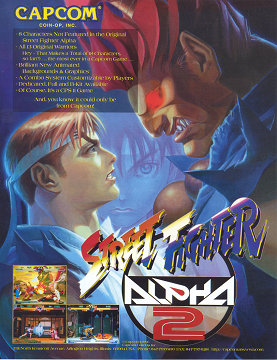
Street Fighter Alpha 2, known as Street Fighter Zero 2 in Japan, Asia, South America, and Oceania, is a 1996 fighting game originally released for the CPS II arcade hardware by Capcom. The game is a remake to the previous year's Street Fighter Alpha: Warriors' Dreams. The game features a number of improvements over the original, such as new attacks, stages, endings, and gameplay features. It was followed by Street Fighter Alpha 3.
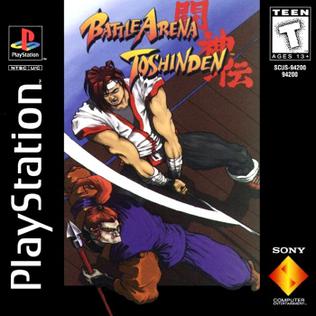
Battle Arena Toshinden is a fighting video game developed by Tamsoft and published by Takara for the PlayStation. Originally released in 1995, it was released internationally by Sony Computer Entertainment, followed by 1996 ports for the Sega Saturn, Game Boy and MS-DOS. It was one of the first fighting games, after Virtua Fighter in 1993 on arcade and console, to boast polygonal characters in a 3D environment, and features a sidestep maneuver which is credited for taking the genre into "true 3D."

X-Men: Children of the Atom is an arcade game that was produced by Capcom and released on the CP System II arcade hardware in 1994 in Japan and in 1995 in North America and Europe.

Virtua Racing or V.R. for short, is a Formula One racing video game developed by Sega AM2 and released for arcades in 1992. Virtua Racing was initially a proof-of-concept application for exercising a new 3D graphics platform under development, the "Model 1". The results were so encouraging that Virtua Racing was fully developed into a standalone arcade title.

Sega AM Research & Development No. 2, previously known as SEGA-AM2 Co., Ltd., is a video game development team within the Japanese multinational video game developer Sega. Yu Suzuki, who had previously developed arcade games for Sega including Hang-On and Out Run, was the first manager of the department.

Virtua Cop 2 is a light gun shooter arcade game, released in 1995 and developed internally at Sega by their AM2 studio. It was ported to the Sega Saturn in 1996, PC in 1997, and Sega Dreamcast in 2000. It was bundled with Virtua Cop in Virtua Cop: Elite Edition for PlayStation 2 in 2002.
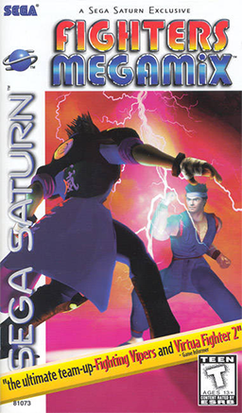
Fighters Megamix is a 1996 fighting game developed by Sega AM2 for the Sega Saturn. It is a crossover between Sega's 3D arcade fighting games Virtua Fighter 2 and Fighting Vipers, with unlockable characters from several other AM2 games such as Virtua Cop 2 and Daytona USA. It allows gamers to play as the bosses of both Virtua Fighter 2 and Fighting Vipers without codes.

Die Hard Arcade, known as Dynamite Deka in Japan, is an arcade beat 'em up video game released by Sega. It was the first beat 'em up to use texture-mapped 3D polygon graphics, and used a sophisticated move set by contemporary beat 'em up standards, often being likened to a fighting game in this respect. It also features quick time events, the ability to combine items to make more powerful weapons, and in two-player mode the ability to perform combined special moves and combos.

Virtua Fighter 2 is a 1994 fighting video game developed by Sega. It is the sequel to Virtua Fighter (1993), and the second game in the Virtua Fighter series. It was created by Sega's Yu Suzuki-headed AM2 and was released for arcades in 1994. Ports were released for the Sega Saturn in 1995 and Microsoft Windows in 1997.
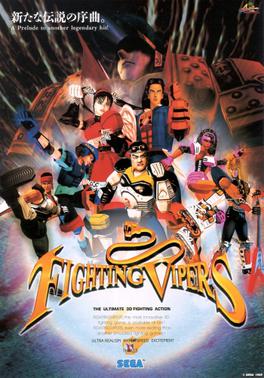
Fighting Vipers is a 3D fighting video game developed by Sega AM2. It uses the same game engine as AM2's Virtua Fighter 2 but features enclosed arenas and an armor mechanic, and was targeted more towards Western audiences, using a U.S. setting and more freeform styles of martial arts. The game was released in the arcade in 1995 using the Sega Model 2 hardware. The game was ported to the Sega Saturn, and to PlayStation Network and Xbox Live Arcade in 2012. Though Fighting Vipers was not very popular in North American arcades, the Saturn version was one of the most high-profile games in the system's 1996 holiday lineup, and was met with positive reviews.

Virtua Fighter 3 is the sequel to 1994's Virtua Fighter 2 and the third fighting game in the Virtua Fighter series, developed by Sega AM2 and published by Sega in 1996. It was the first arcade game to run on the Sega Model 3 system board.

Battle Arena Toshinden 2 is a fighting video game developed by Tamsoft and published by Takara. It was released for the PlayStation and arcades in 1995, with the arcade version published by Capcom, followed by a port to PC. It is the sequel to Battle Arena Toshinden, and was a departure from the usual fighting game formula in that it was developed for home console first, with the arcade version being developed later. In some countries the arcade version was also released after the PlayStation version. The game was less enthusiastically received than the original Battle Arena Toshinden, with critics saying that both the gameplay and graphics made too little advancement over its predecessor, failing to keep pace with competing fighting games.

Dead or Alive is a 1996 fighting game by Tecmo and the first entry in Team Ninja's long-running Dead or Alive series. It was released first in arcades, followed by home ports for the Sega Saturn in Japan, and later for the PlayStation in all regions.

Virtual On: Cyber Troopers is a 1996 video game developed and published by Sega. A 3D shooting and fighting game featuring robots, it was released in arcades and for Sega Saturn and PC, in both America and Japan. There were also two-player online versions of the game released in America and Japan for the Sega Saturn using the NetLink and XBAND services. Initially the game was to be released under the title "Virtual On" in Japan and "Cyber Troopers" in North America, but ultimately these two names were combined into a single title for both regions.
Virtua Fighter is a series of fighting games created by Sega AM2 and designer Yu Suzuki. The original Virtua Fighter was released in December 1993 and has received four main sequels and several spin-offs. The highly influential first Virtua Fighter game is widely recognized as the first 3D fighting game released.
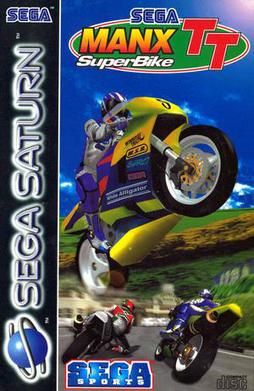
Manx TT Super Bike is a 1995 arcade racing game developed jointly by Sega AM3 and Sega-AM4. It is a motorcycle racing game built for the Sega Model 2 arcade board. Up to 8 players can race in this game if enough arcade cabinets are linked together, following on from Daytona USA. It was later ported to the Sega Saturn by Tantalus Interactive and to Windows by Perfect Entertainment.
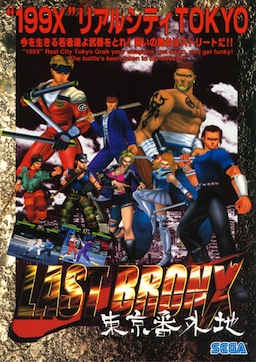
Last Bronx is a 3D fighting video game developed by Sega AM3 on the Sega Model 2 mainboard. It was released in Japan in game centers in 1996. Home versions of Last Bronx were produced for the contemporary Sega Saturn and Windows systems. In Japan, Last Bronx was novelized and serialized into comics and radio drama. A VHS video documenting the motion capture process used for the game and introducing the characters was released in 1996. A year later, Takashi Shimizu directed the live-action movie (V-Cinema). On June 29, 2006, Sega released Last Bronx on PlayStation 2 as a tenth anniversary celebration.

Daytona USA: Championship Circuit Edition, or Daytona USA: Circuit Edition in Japan, is a racing game by Sega, specifically designed for the Sega Saturn. Released in 1996, it is a reworked and extended version of the original Daytona USA, and was developed by Sega AM3, the same team that oversaw the Saturn port of Sega Rally Championship, by using a modified version of the Sega Saturn engine of Sega Rally Championship.



















